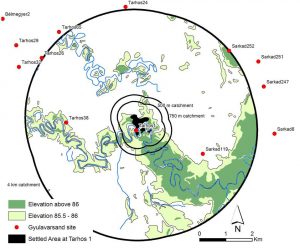My dissertation research evaluated the common claim that Middle Bronze Age societies in eastern Hungary (c. 2150-1400 BC) were chiefdoms with craft production and an elite class based at fortified tell sites. During this classical phase of the Bronze Age, the Ottomány (Otomani) and Gyulavarsánd cultures were responsible for producing exquisite metal artefacts and ornately decorated ceramics. In many instances, fortified sites not only formed tell deposits, but large occupations grew around them, resulting in regional centers in a site size hierarchy. Nonetheless, excavation bias favouring stratified tells has yielded a lop-sided picture of societies in this region.
The Bronze Age Körös Off-Tell Archaeology (BAKOTA) project was initiated in 2006 to rectify the imbalance, using measures for chiefdoms to ascertain the extent of social inequalities. Excavation at a small hamlet, Tarhos Gyepesi Átkelő (Tarhos 26), produced house data for comparison to tell sites. The dimensions of the identified structure and the materials used to make it were all within the range of houses known from fortified sites. The midden debris and contents of the house didn’t differ in significant ways from the diet and material culture known from tell sites nearby either.

Farming catchments at Békés-Várdomb Cluster (Tarhos 1 and surrounding sites). In the lower Körös basin, very small differences in topography determine which areas would have been dry enough to farm (in green). Intensive garden agriculture would have characterized food production close to the settlement, but plough agriculture could have been used in a larger catchment (Image credit: P. Duffy)
A catchment analysis and population estimate for several fortified sites in the lower Körös basin indicated that although villages may have swelled to 500 people in rare instances, at no point did the village’s caloric needs exceed the productive capacities of the catchments. This weighs against the idea that the fortified regional centers needed to extract agricultural surplus from villages in the hinterland to support its population.
Analyses of metallurgical slag collected from tell sites and outlying villages also weigh in on our understanding of metallurgical practices in the region. Research by Dr. Christopher Papalas established that slags identified on both types of sites resulted from the primary smelting of ores. Bronze production was therefore not monopolized by the fortified centers, and ores may have been traded over long distances or obtained through direct procurement.
